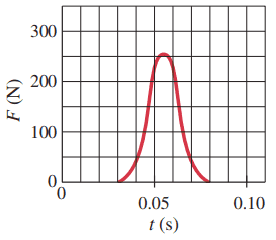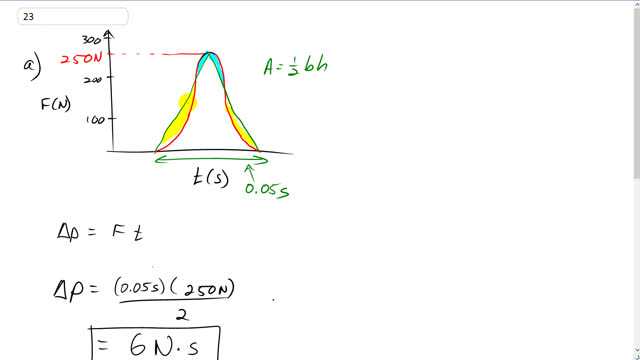
Suppose the force acting on a tennis ball (mass 0.060 kg) points in the +x direction and is given by the graph of Fig. 7–33 as a function of time.
- Use graphical methods (count squares) to estimate the total impulse given the ball.
- Estimate the velocity of the ball after being struck, assuming the ball is being served so it is nearly at rest initially. [Hint: See Section 6–2.]


In order to watch this solution you need to have a subscription.
This is Giancoli Answers with Mr. Dychko. To estimate the total impulse given to the ball, we have to estimate what the area is around this force versus time curve and I'm gonna do it by making a triangle here that looks like it somewhat has the same area as the area into the curve. Now the triangle exceeds the curve area where it's shaded yellow and it has a compensatingly less area than the curve with this blue shaded area so hopefully the amount by which the triangle is below the curve in the blue shaded hopefully equals the amount by which the triangle is above the curve with this yellow area so that it does in fact equal the area under the curve, roughly anyway right. So the area of this triangle is one-half base times height and the base is 0.05 seconds and the height it looks like it's about 250 newtons and so the impulse is force times time so that's gonna be 250 newtons times this time all divided by 2 because that's what the formula is for the area of this triangle so I'm not plugging directly into this formula what I'm really plugging into is that the impulse equals that and it equals the area under F versus T curve—that's really what I'm doing— and that's about 6 newton seconds or you could write 6 kilogram meters per second but newton second kinda makes sense here because I'm multiplying this force newtons by this seconds here; either unit is fine. And figure out the final velocity of this tennis ball; its impulse equals the change in momentum and that's the final momentum minus the initial momentum but initially, it starts at rest so that disappears and so just switch the sides around so we have mv f equals ΔP, divide both sides by m and you get the final speed is the impulse divided by the mass or 6.25 kilogram meters per second divided by 0.060 kilograms and I'm using the unrounded answer from my estimate for the area under the curve in this calculation to avoid intermediate rounding error and we get about 100 meters per second.